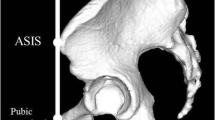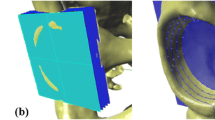Abstract
Published studies of the human hip make frequent reference to the normal pelvis and acetabulum. However, other than qualitative descriptions we found no clinically applicable published references describing a normal pelvis and acetabulum; such information is important for designing certain kinds of implants (eg, reconstruction cages). We describe a method to quantify, average, and apply data gathered from normal human specimens to create a standard representation of the ilium and ischium. One hundred healthy hemipelves from 50 human skeletons were evaluated. We measured angles and distances between major anatomic landmarks in the pelvis. The data collected were analyzed for variance and averaged to create a normal topographic map. Finally, we examined several commercially available acetabular reconstruction cages to determine the fit to the anatomically determined normal pelvis. These results provide a representation of true acetabular geometry and may serve as the basis for future acetabular reconstruction cage design.







Similar content being viewed by others
References
American Association of Orthopaedic Surgeons. Osteoarthritis of the hip: hip joint replacement. October 2003. Available at: http://www.aaos.org/Research/documents/oainfo_hip.asp. Accessed April 22, 2008.
Attias N, Lindsey RW, Starr AJ, Borer D, Bridges K, Hipp JA. The use of a virtual three-dimensional model to evaluate the intraosseous space available for percutaneous screw fixation of acetabular fractures. J Bone Joint Surg Br. 2005;87:1520–1523.
Benedetti JA, Ebraheim NA, Xu R, Yeasting RA. Anatomic considerations of plate-screw fixation of the anterior column of the acetabulum. J Orthop Trauma. 1996;10:264–272.
Brinckmann P, Hoefert H, Jongen HT. Sex difference in the skeletal geometry of the human pelvis and hip joint. J Biomech. 1981;14:427–430.
D’Lima DD, Urquhart AG, Buehler KO, Walker RH, Colwell CW Jr. The effect of the orientation of the acetabular and femoral components on the range of motion of the hip at different head-neck ratios. J Bone Joint Surg Am. 200;82:315–321.
Govsa F, Ozer MA, Ozgur Z. Morphologic features of the acetabulum. Arch Orthop Trauma Surg. 2005;125:453–461.
Husmann O, Rubin RJ, Leyvraz PF, de Roguin B, Argenson JN. Three-dimensional morphology of the proximal femur. J Arthroplasty. 1997;12:444–450.
Lavernia CJ, Cook CC, Hernandez RA, Sierra RJ, Rossi MD. Neurovascular injuries in acetabular reconstruction cage surgery: an anatomical study. J Arthroplasty. 2007;22:124–132.
Lewinnek GE, Lewis JL, Tarr R, Compere CL, Zimmerman JR. Dislocations after total hip replacement arthroplasties. J Bone Joint Surg Am. 1978;60:217–220.
Maruyama M, Feinberg JR, Capello WN, D’Antonio JA. The Frank Stinchfield Award: Morphologic features of the acetabulum and femur: anteversion angle and implant positioning. Clin Orthop Relat Res. 2001;393:52–65.
Meldrum R, Johansen RL. Safe screw placement in acetabular revision surgery. J Arthroplasty. 2001;16:953–960.
Mensforth RP, Latimer BM. Hamann-Todd Collection aging studies: osteoporosis fracture syndrome. Am J Phys Anthropol.1989:80:461–479.
Noble PC, Alexander JW, Lindahl LJ, Yew DT, Granberry WM, Tullos HS. The anatomic basis of femoral component design. Clin Orthop Relat Res. 1988;235:148–165.
Sporer SM, Paprosky WG, O’Rourke MR. Managing bone loss in acetabular revision. Instr Course Lect. 2006;55:287–297.
Tague RG. Variation in pelvic size between males and females. Am J Phys Anthropol. 1989;80:59–71.
Wasielewski RC, Cooperstein LA, Kruger MP, Rubash HE. Acetabular anatomy and the transacetabular fixation of screws in total hip arthroplasty. J Bone Joint Surg Am. 1990;72:501–508.
Acknowledgments
We thank Kate Sutton, Alvin Perez, and Jianhua Shen from Stryker Orthopaedics and Lyman Jellema, Director of the Hamann-Todd Collection at the Cleveland Museum of Natural History, for assistance throughout this study.
Author information
Authors and Affiliations
Corresponding author
Additional information
The following authors (VK, SJI, WHS) certify they have received payments or benefits from a commercial entity (Stryker Orthopaedics) related to this work.
Each author certifies that his or her institution has approved or waived the human protocol for this investigation, that all investigations were conducted in conformity with ethical principles of research.
About this article
Cite this article
Krebs, V., Incavo, S.J. & Shields, W.H. The Anatomy of the Acetabulum: What is Normal?. Clin Orthop Relat Res 467, 868–875 (2009). https://doi.org/10.1007/s11999-008-0317-1
Received:
Accepted:
Published:
Issue Date:
DOI: https://doi.org/10.1007/s11999-008-0317-1




